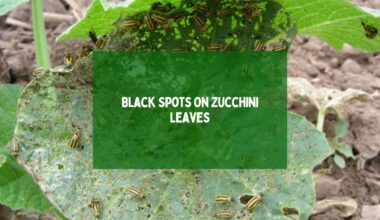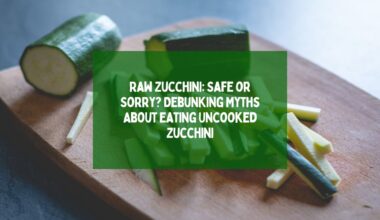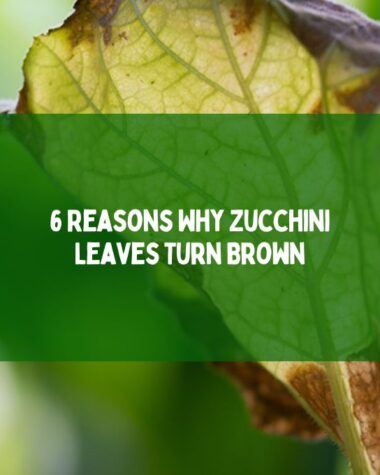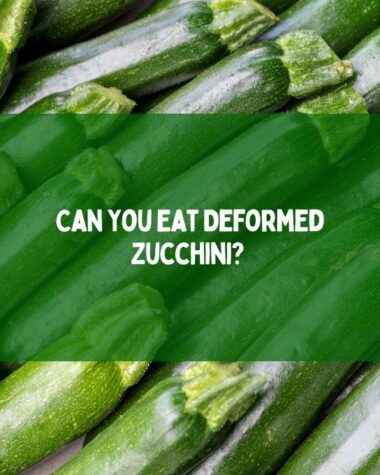Numerous things, such as bacterial and fungal infections, insect infestations, environmental stress, or improper watering, can contribute to the development of these spots. These spots can start as small, discolored areas but can grow larger and spread, eventually leading to the death of the entire leaf.
Zucchini plant are a popular choice for home gardeners due to their relatively easy cultivation and delicious fruit. However, one common problem that gardeners may encounter is the appearance of brown spots on zucchini leaves.
Identifying the cause of brown spots on zucchini leaves is crucial to preventing the problem from spreading and damaging the plant.
In this topic, we will discuss some of the common reasons for brown spots on zucchini leaves and how to prevent or treat them.
8 Reasons for Brown Spots on Zucchini Leaves

The reasons why brown spots appear on zucchini leaves are given below:
Related Reading
- Pruning Zucchini Plant: Maximize Your Zucchini Harvest with Pruning
- How to Find, Prevent, and Treat Zucchini Plant Problems?
- What is bumpy zucchini? Why is my zucchini bumpy?
- How to Harvest Zucchini: Tips and Techniques to Ensure a Rich Harvest
1. Fungal Diseases
Fungal diseases are one of the common causes of brown spots on zucchini leaves. Fungi are known to thrive in warm, humid environments, making them a particular problem during the wet summer months.
Common fungal diseases that affect zucchini plants include powdery mildew, downy mildew, and anthracnose.
- Powdery mildew appears as a white or grayish powder on the upper surface of the leaves.
- Downy mildew appears as yellow or brown spots on the undersides of the leaves.
- Anthracnose appears as dark brown or black spots on the leaves.
Prevention
To manage fungal diseases, it is essential to maintain good garden hygiene by removing any infected plant parts and cleaning garden tools to prevent the spread of the disease. Fungicides may also be used to control the spread of the disease.
2. Nutrient Deficiencies

When plants lack essential nutrients, they may develop brown or yellow spots on their leaves.
One common nutrient deficiency that affects zucchini plants is a lack of magnesium, which can cause brown spots on older leaves. Too acidic or too alkaline soil can impair the plant’s ability to absorb magnesium, which is a common cause of this deficiency.
Zinc deficiency can also cause brown spots on zucchini leaves, which may appear as small brown patches.
Prevention
It is important to test the soil to determine which nutrients are lacking. Once the specific nutrient deficiency has been identified, it can be addressed through fertilization with the appropriate nutrients.
Organic matter such as compost can also be added to the soil to improve soil health and nutrient availability.
3. Overwatering
Overwatering is another common cause of brown spots on zucchini leaves, which can lead to root rot and other problems. The plant becomes stressed, which can make it more susceptible to disease and pest infestations.
When zucchini plants are overwatered, the leaves may develop brown spots or patches that are soft and mushy to the touch. Sometimes, the leaves may start to wilt or even fall off.
Prevention
To prevent overwatering, it is important to water the plants only when necessary and to avoid watering the foliage. The soil should be allowed to dry out slightly between waterings, and excess water should be allowed to drain away from the plant.
4. Environmental Stress
Environmental stress can also cause brown spots on zucchini leaves. Zucchini plants can be sensitive to changes in temperature, humidity, and light, which can lead to stress and the development of brown spots on the leaves.
- Extreme heat or cold can cause brown spots to form on zucchini leaves.
- High humidity levels can also cause fungal diseases to develop, which can lead to the formation of brown spots.
Prevention
Provide the plant with appropriate growing conditions.
This may include planting the zucchini in an area that receives partial shade during the hottest part of the day, providing adequate moisture levels, and protecting the plants from extreme weather conditions. Improving air circulation and reducing moisture levels can help prevent fungus diseases.
5. Sunscald

Sunscald occurs when the leaves are exposed to direct sunlight for an extended period of time, causing them to become sunburned and develop brown patches or spots.
The leaves of zucchini plants that have been recently transplanted or are experiencing drought stress are also more susceptible to sunscald.
Prevention
To prevent sunscald, provide the zucchini plant with adequate shade during the hottest days. This may include planting the zucchini in a location that receives partial shade or using shade cloth to protect the plant from direct sunlight.
6. Insect Damage
Insect damage is another common cause of brown spots on zucchini leaves. Insects such as aphids, spider mites, and thrips can cause damage to the leaves of zucchini plants, leading to the formation of brown spots.
- Aphids feed on the sap of the plant, which can cause the leaves to become distorted and yellow or brown spots to form.
- Spider mites can cause similar damage as they feed on the underside of the leaves, causing yellow or brown spots to develop.
- Thrips can also cause damage to the leaves, leading to the formation of brown spots or patches.
Prevention
It is important to monitor the plants regularly for signs of infestation. In some cases, the use of insecticidal soaps or oils may be necessary to control the insects. Using natural predators such as ladybugs or lacewings can help keep insect populations under control.
7. Bacterial Diseases
Pseudomonas syringae and Xanthomonas campestris are two examples of the bacteria that can cause these diseases.
The symptoms of bacterial diseases in zucchini plants can include the formation of brown spots on the leaves as well as wilting, yellowing, or stunted growth. These diseases can spread quickly and cause significant damage to the plant if left untreated.
Prevention
Daily practice good sanitation and crop rotation practices. Diseased plants should be removed and destroyed immediately to prevent the spread of bacteria. Avoiding overhead irrigation and keeping the foliage dry can help reduce the risk of bacterial infections.
8. Soil fertilizers
Soil fertilizers can also cause brown spots on zucchini leaves. While fertilizers can provide the necessary nutrients for plant growth, excessive use or improper application can lead to a buildup of salts in the soil, which can cause leaf burn and the formation of brown spots.
Over-fertilizing can also cause the plant to become stressed, which can make it more susceptible to disease and pest infestations.
Prevention
Follow proper fertilization practices.
This may include testing the soil to determine nutrient levels before applying fertilizer, using slow-release fertilizers that release nutrients gradually over time, and avoiding the use of fertilizers in excessive amounts. Incorporating organic matter into the soil can help improve soil health and nutrient availability for plants.
Related Reading
- 10 Reasons Your Tomato Plant Leaves Are Turning Brown
- Why Are My Pumpkin Leaves Turning Yellow?
- What Causes Cucumber Leaves Turn White? How to Fix It?
- Why are Cucumber Leaves Wilting and Dying? Reasons and Solutions
- Complete Aubergine Planting Guide: Tips and Strategies for Successful Cultivation
- A Comprehensive Guide to the Different Types of Evergreen Trees
Conclusion
Zucchini plants are vulnerable to various diseases and pests that can cause brown spots on their leaves. There are many causes of these, including bacterial diseases, soil fertilizers, sunscald, insect damage, nutrient deficiencies, overwatering, environmental stress, and fungal diseases.
To prevent brown spots, it is important to provide the zucchini plant with appropriate growing conditions. Regular monitoring and prompt action can help prevent and control these issues, ensuring a healthy and productive zucchini harvest.
Thanks for reading!







